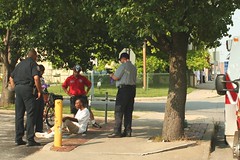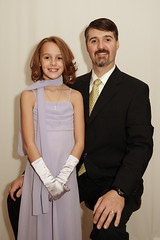Lately, I carry my camera everywhere. Often that means I am the only photographer onsite when something interesting happens. On the way to my class in Westport, I saw a man who was stumbling around and speaking to himself. This is not especially odd behavior for this area as it is inner city, and it is not uncommon to see people that are either drunk, on drugs, or with some other mental or physical condition that causes such behavior.
Someone thought this was unusual enough to call an ambulance, however, so when the paramedics stopped a block away, I grabbed the camera and went to investigate. I was not surprised they were working on the same man I had seen and decided to see what kind of photographs I could get.
Taking candid photographs of people I don't know in a public setting is still something I am getting used to. I had to do a fair amount of research to figure out where the legal lines were so I could decide when I could and could not take photographs. From a legal standpoint I found I can pretty much photograph anything in public as long as I don't plan to use it commercially (such as in advertising). However, taking legal photographs is not always the same as taking ethical photographs. There is a time not to take a photograph and this entry has more to do with whether a photograph is ethical rather than legal.
For instance, I had no ethical qualms about photographing this scene as the paramedics were already onsite and treating the victim. Had I come across a car accident where people needed help and no ambulance had been called, I would have to be crazy to pull out the camera and start taking photographs. But if help was already there, and the people were being treated, I would probably begin taking photographs. "Why?", you ask? Because it is news worthy. When I open a newspaper and I see photographs of an accident from yesterday, I feel the photograph adds to the story and is therefore important. I don't even think to ask if the photographer who took the photograph should have done it or not?
Now, this is the first opportunity I have had to take this kind of photograph so I forgot to do some important things. I probably could have turned this into a news story if I had remembered to speak to the people and get the specifics about what happened and who the people were. It has been difficult for me to get over the shyness of taking photographs of strangers and speaking to them in a tense situation is even more difficult, so I am taking this in steps. The first step is to get used to taking the "hard" photographs. Next time I hope I can work up the courage to speak to those involved.
Subscribe to:
Post Comments (Atom)




No comments:
Post a Comment